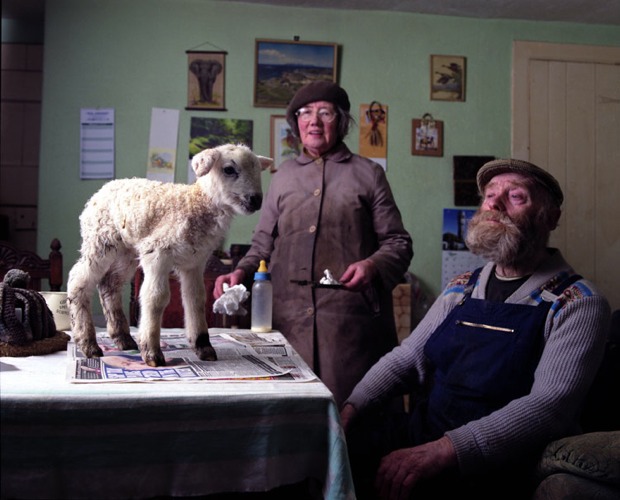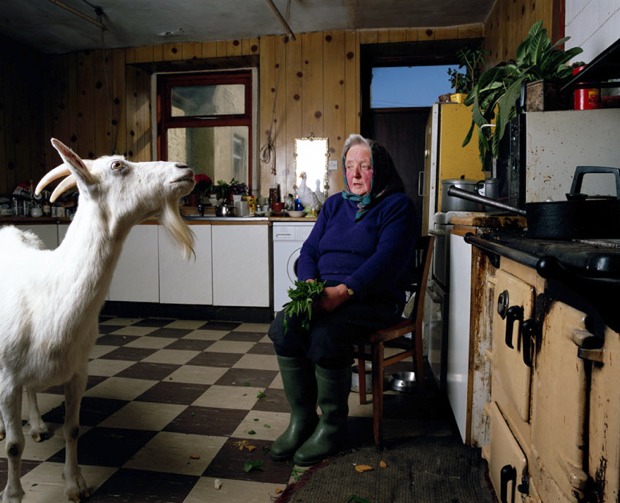Fancy Pictures
2008
‘Fancy Pictures’, 16mm film, 18mins
‘Tula Fancies’, Medium format audio-slide show featuring 45 photographs, 14 mins
‘Four photographs for the Bedroom’, four prints, 85cm x 70cm
Commissioned by Mount Stuart Trust, and installed at the Visitor Centre, and Mount Stuart House, Isle of Bute, Scotland, 2008
‘Fancy Pictures’ (16mm film loop, 18 min, silent, 2008)
The term ‘Fancies’ was first used in 1737 by art chronicler George Vertue to describe paintings by Mercier of scenes of everyday life, but with elements of imagination, invention or storytelling. Later, the name ‘fancy pictures’ was given by Sir Joshua Reynolds to the supreme examples of the genre produced by Gainsborough in the decade before his death in 1788, featuring rural life in particular.
Shot in the grounds of Mount Stuart and on Bute farms, the film ‘Fancy Pictures’ features several ultra slow motion sequences of indigenous animal life filmed in front of backdrops taken from Eighteenth and Nineteenth Century portrait paintings in the Dining Room at Mount Stuart. The portraits include works by Sir Joshua Reynolds, Allan Ramsay and Sir Henry Raeburn. The film questions the role of landscape in portrait painting, the changing relationships between landowners and animal life, and creature symbolism in film history.
Technological advances in photographic techniques, and how we use them to frame animals, say as much about value systems in Britain today, as a painting by Reynolds tells us about the aristocracy’s relationship to the land two hundred years ago. This connection was made using backdrops, so that the wildlife action in the foreground seems like an elegant graffiti.
‘Tula Fancies’ (audio-slide installation, 45 stills looped, 14min, 2008)
Neville’s photographs of rural life on Bute reference Old Master painting, scientific imagery, wildlife books, Soviet pictorial types of the 1920’s, editorial, social documentary, and fashion photography. The slide projected images collectively suggest that there is a mystical, religious relationship between animal life and the island community, present in the reality of rural life, but also evident throughout the art and craft works commissioned for centuries in Mount Stuart House itself. The variety of photographic genres Neville employs works to undermine the notion of a unified, authentic, social documentary vision, in favour of a fluctuating depiction of identity.
The title of the work refers both to the 18th century term in British painting, ‘fancies’, designating imaginative scenes of quotidian rural life, but also to Tula, an agricultural region in Russia. Neville approached the taking of each image on Bute as if he were imagining a document of the Soviet Union, searching for faces, landscapes, and scenes that seemed to resonate with his knowledge of existing imagery found both in social documentary photographs and Russian Cinema. Further investigating the validity of this comparison, the artist then presented twenty of the images to a head boy and head girl at local school Rothesay Academy, claiming the shots were taken in Tula, and asked them to make an accompanying soundtrack inspired by mother Russia. The resulting, haunting soundtrack is the work of Megan Alexander and Kerr Slaven, and is inspired by the images and the misinformation about their origin that was provided.
‘Photographs for the House’ (group of four framed prints, 2008)
‘Goat Pedicure’ (silver gelatin fibre print, 64cm x 75cm, 2008)
‘Mr and Mrs Curry’ (cibachrome print, 75cm x 85cm, 2008)
‘Supper’ (c-type print, 75cm x 85cm, 2008)
‘Newborn Lamb’ (c-type print, 75cm x 85cm, 2008)
Four photographic portraits of people and places from the Isle were hung in the House, grouped together. They contain subtle and contradictory references both to the history of photography and to painting. The images reference the House’s relationship to painting sometimes through the poses of its subjects, which may seem to echo Gainsborough’s ‘Mr and Mrs. Andrews’, or sometimes through the lighting, which might quote Caravaggio’s ‘Supper at Emmaus’. However, they simultaneously also refer to the impulse in 1920’s social documentary photography, later common in Soviet pictorial types, to orchestrate its subjects into stylized compositions that glorify the relationship between people and the land. The suggestion being, that it is people, not machines, that are the source of a country’s wealth. This message is counterbalanced with the contradictory references to painting genres which reinforce the idea that power is a result of land ownership, and that images should foremost be aesthetically pleasing in order to communicate.
IN THE PRESS
Interview with David Brittain, Source, Autumn 2009
Martin Vincent, Mount Stuart, Art monthly - Jul-Aug 2008
Neil Cooper, 'Fancy Pictures', The List - Jul 2008
'Academy duo's sound of music', Buteman - 6 June 2008
Keith Bruce, 'Soviet Fantasy', The Herald - 19 May 2008
'Fancy Pictures', Buteman - 16 May 2008
Martin Vincent, 'Workers of the World', Metro - 15 May 2008
Susan Mansfield, 'Fancy Pictures', The Scotsman - 9 May 2008
Jonathan Griffin, 'Now Showing 2', 2010

Selected Works from the series

‘Newborn Lamb’ from the Audio slide installation ‘Tula Fancies’, Mark Neville, 2008

‘Animal Farm’ from the audio slide installation ‘Tula Fancies’, Mark Neville, 2008

‘Annie and Snowy’, from the Audio slide installation ‘Tula Fancies’ , Mark Neville, 2008

‘Blue Tit Flight’ from the audio slide installation ‘Tula Fancies’, Mark Neville 2008

‘Fancy’ from the Audio slide installation ‘Tula Fancies’, Mark Neville, 2008

‘Goat Pedicure’, from the Audio slide installation, ‘Tula Fancies’, Mark Neville, 2008/

‘Supper’, from the Audio slide installation ‘Tula Fancies’, Mark Neville, 2008

Sheriff from the Audio slide installation ‘Tula Fancies’, Mark Neville, 2008

Installation at Mount Stuart

Photographs for the House (group of four framed prints, 2008)

Film installation shot

Slide installation shot

Production still from ‘Fancy Pictures’ ( 16mm film, 18 mins, 2008) Mark Neville
